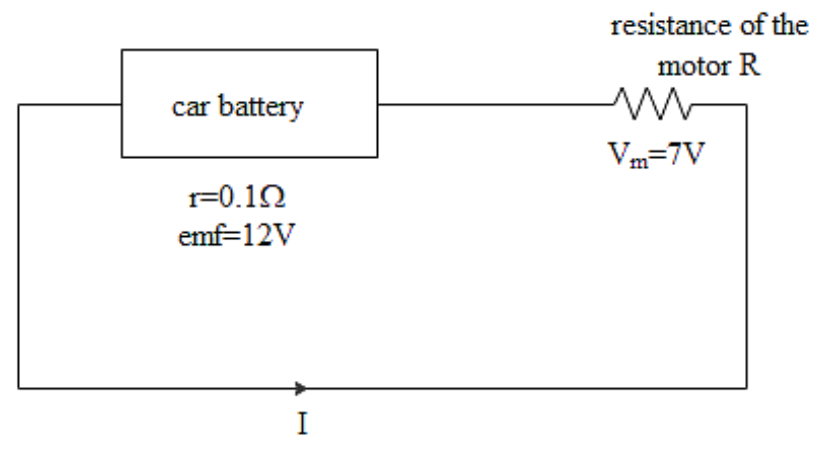
Answer
453.3k+ views
Hint: First of all the current in the circuit is to be calculated. When the current is calculated, the internal resistance is to be taken care of. As the potential difference across the battery terminal has been given, we can equate the potential difference equation, which is the product of the current through the circuit and the resistance of the motor. These all may help you to solve this question.
Complete step-by-step solution:

Let us suppose that the resistance of the motor is $R$. Therefore the current in the circuit will be given as,
$I=\dfrac{V}{R+r}$
Where $V$be the voltage in the circuit, $r$ be the internal resistance of the battery.
It is already mentioned in the question that,
$\begin{align}
& V=12V \\
& r=0.1\Omega \\
\end{align}$
So let us substitute this in the equation,
$I=\dfrac{12}{R+0.1}$
As the potential difference across the motor is given as
\[{{V}_{m}}=7V\]
We can write that,
\[\left( \dfrac{12}{0.1+R} \right)\times R=7V\]
Which is by the ohm’s law which gives the relation as,
\[V=IR\]
We can rearrange this equation and rewrite as,
\[12R=7\left( 0.1+R \right)\]
From this, the value of the resistance can be found,
That is,
\[\begin{align}
& R=\dfrac{0.7}{5}\Omega \\
& R=0.14\Omega \\
\end{align}\]
We obtained the value of resistance. Therefore now let us substitute this in the equation of current,
$\begin{align}
& I=\dfrac{V}{R+r} \\
& \because R=0.14\Omega \\
& I=\dfrac{12}{0.1+0.14}A \\
& I=50A \\
\end{align}$
Therefore, the correct answer has been obtained. The answer is given as option A.
Note: Ohm’s law states that the voltage in a circuit is proportional to the current flowing through the circuit. The proportionality used in this relation is known as resistance. The value of resistance depends on the length of the material, the area of the cross-section, and the nature of the material.
Complete step-by-step solution:

Let us suppose that the resistance of the motor is $R$. Therefore the current in the circuit will be given as,
$I=\dfrac{V}{R+r}$
Where $V$be the voltage in the circuit, $r$ be the internal resistance of the battery.
It is already mentioned in the question that,
$\begin{align}
& V=12V \\
& r=0.1\Omega \\
\end{align}$
So let us substitute this in the equation,
$I=\dfrac{12}{R+0.1}$
As the potential difference across the motor is given as
\[{{V}_{m}}=7V\]
We can write that,
\[\left( \dfrac{12}{0.1+R} \right)\times R=7V\]
Which is by the ohm’s law which gives the relation as,
\[V=IR\]
We can rearrange this equation and rewrite as,
\[12R=7\left( 0.1+R \right)\]
From this, the value of the resistance can be found,
That is,
\[\begin{align}
& R=\dfrac{0.7}{5}\Omega \\
& R=0.14\Omega \\
\end{align}\]
We obtained the value of resistance. Therefore now let us substitute this in the equation of current,
$\begin{align}
& I=\dfrac{V}{R+r} \\
& \because R=0.14\Omega \\
& I=\dfrac{12}{0.1+0.14}A \\
& I=50A \\
\end{align}$
Therefore, the correct answer has been obtained. The answer is given as option A.
Note: Ohm’s law states that the voltage in a circuit is proportional to the current flowing through the circuit. The proportionality used in this relation is known as resistance. The value of resistance depends on the length of the material, the area of the cross-section, and the nature of the material.
Recently Updated Pages
Identify the feminine gender noun from the given sentence class 10 english CBSE

Your club organized a blood donation camp in your city class 10 english CBSE

Choose the correct meaning of the idiomphrase from class 10 english CBSE

Identify the neuter gender noun from the given sentence class 10 english CBSE

Choose the word which best expresses the meaning of class 10 english CBSE

Choose the word which is closest to the opposite in class 10 english CBSE

Trending doubts
Fill the blanks with the suitable prepositions 1 The class 9 english CBSE

Which are the Top 10 Largest Countries of the World?

Change the following sentences into negative and interrogative class 10 english CBSE

Difference between Prokaryotic cell and Eukaryotic class 11 biology CBSE

10 examples of friction in our daily life

How do you graph the function fx 4x class 9 maths CBSE

Give 10 examples for herbs , shrubs , climbers , creepers

The Equation xxx + 2 is Satisfied when x is Equal to Class 10 Maths

What is pollution? How many types of pollution? Define it




